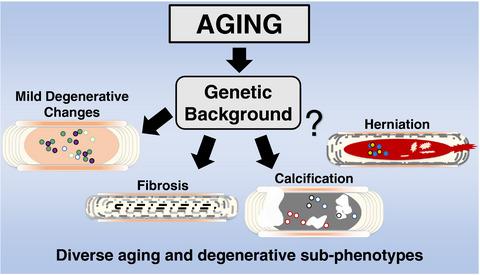当前位置:
X-MOL 学术
›
Aging Cell
›
论文详情
Our official English website, www.x-mol.net, welcomes your feedback! (Note: you will need to create a separate account there.)
Comparison of inbred mouse strains shows diverse phenotypic outcomes of intervertebral disc aging.
Aging Cell ( IF 7.8 ) Pub Date : 2020-04-22 , DOI: 10.1111/acel.13148 Emanuel J Novais 1, 2, 3, 4 , Victoria A Tran 1 , Jingya Miao 1 , Katie Slaver 1 , Andrew Sinensky 1 , Nathaniel A Dyment 5 , Sankar Addya 6 , Flora Szeri 7, 8, 9 , Koen van de Wetering 7, 8, 9 , Irving M Shapiro 1, 2 , Makarand V Risbud 1, 2
Aging Cell ( IF 7.8 ) Pub Date : 2020-04-22 , DOI: 10.1111/acel.13148 Emanuel J Novais 1, 2, 3, 4 , Victoria A Tran 1 , Jingya Miao 1 , Katie Slaver 1 , Andrew Sinensky 1 , Nathaniel A Dyment 5 , Sankar Addya 6 , Flora Szeri 7, 8, 9 , Koen van de Wetering 7, 8, 9 , Irving M Shapiro 1, 2 , Makarand V Risbud 1, 2
Affiliation

|
Intervertebral disc degeneration presents a wide spectrum of clinically degenerative disc phenotypes; however, the contribution of genetic background to the degenerative outcomes has not been established. We characterized the spinal phenotype of 3 mouse strains with varying cartilage‐regenerative potential at 6 and 23 months: C57BL/6, LG/J and SM/J. All strains showed different aging phenotypes. Importantly, LG/J mice showed an increased prevalence of dystrophic disc calcification in caudal discs with aging. Quantitative‐histological analyses of LG/J and SM/J caudal discs evidenced accelerated degeneration compared to BL6, with cellular disorganization and cell loss together with fibrosis of the NP, respectively. Along with the higher grades of disc degeneration, SM/J, at 6M, also differed the most in terms of NP gene expression compared to other strains. Moreover, although we found common DEGs between BL6 and LG/J aging, most of them were divergent between the strains. Noteworthy, the common DEGs altered in both LG/J and BL6 aging were associated with inflammatory processes, response to stress, cell differentiation, cell metabolism and cell division. Results suggested that disc calcification in LG/J resulted from a dystrophic calcification process likely aggravated by cell death, matrix remodelling, changes in calcium/phosphate homeostasis and cell transformation. Lastly, we report 7 distinct phenotypes of human disc degeneration based on transcriptomic profiles, that presented similar pathways and DEGs found in aging mouse strains. Together, our results suggest that disc aging and degeneration depends on the genetic background and involves changes in various molecular pathways, which might help to explain the diverse phenotypes seen during disc disease.
中文翻译:

近交系小鼠品系的比较显示出椎间盘老化的不同表型结果。
椎间盘退变呈现出广泛的临床退变椎间盘表型;然而,遗传背景对退化结果的影响尚未确定。我们对 6 个月和 23 个月时具有不同软骨再生潜力的 3 个小鼠品系的脊柱表型进行了表征:C57BL/6、LG/J 和 SM/J。所有菌株均表现出不同的衰老表型。重要的是,随着年龄的增长,LG/J 小鼠尾椎间盘营养不良性椎间盘钙化的患病率增加。LG/J 和 SM/J 尾椎间盘的定量组织学分析表明,与 BL6 相比,其退化加速,分别出现细胞解体和细胞损失以及 NP 纤维化。除了椎间盘退变程度较高之外,6M 时的 SM/J 与其他菌株相比,在 NP 基因表达方面也存在最大差异。此外,虽然我们发现 BL6 和 LG/J 老化之间存在共同的 DEG,但其中大多数在菌株之间是不同的。值得注意的是,LG/J 和 BL6 衰老过程中常见的 DEG 改变与炎症过程、应激反应、细胞分化、细胞代谢和细胞分裂有关。结果表明,LG/J 中的椎间盘钙化是由营养不良性钙化过程引起的,该过程可能因细胞死亡、基质重塑、钙/磷酸盐稳态变化和细胞转化而加剧。最后,我们根据转录组图谱报告了 7 种不同的人类椎间盘退变表型,这些表型在衰老小鼠品系中发现了相似的途径和 DEG。总之,我们的结果表明,椎间盘老化和退变取决于遗传背景,并涉及各种分子途径的变化,这可能有助于解释椎间盘疾病期间观察到的不同表型。
更新日期:2020-04-22
中文翻译:

近交系小鼠品系的比较显示出椎间盘老化的不同表型结果。
椎间盘退变呈现出广泛的临床退变椎间盘表型;然而,遗传背景对退化结果的影响尚未确定。我们对 6 个月和 23 个月时具有不同软骨再生潜力的 3 个小鼠品系的脊柱表型进行了表征:C57BL/6、LG/J 和 SM/J。所有菌株均表现出不同的衰老表型。重要的是,随着年龄的增长,LG/J 小鼠尾椎间盘营养不良性椎间盘钙化的患病率增加。LG/J 和 SM/J 尾椎间盘的定量组织学分析表明,与 BL6 相比,其退化加速,分别出现细胞解体和细胞损失以及 NP 纤维化。除了椎间盘退变程度较高之外,6M 时的 SM/J 与其他菌株相比,在 NP 基因表达方面也存在最大差异。此外,虽然我们发现 BL6 和 LG/J 老化之间存在共同的 DEG,但其中大多数在菌株之间是不同的。值得注意的是,LG/J 和 BL6 衰老过程中常见的 DEG 改变与炎症过程、应激反应、细胞分化、细胞代谢和细胞分裂有关。结果表明,LG/J 中的椎间盘钙化是由营养不良性钙化过程引起的,该过程可能因细胞死亡、基质重塑、钙/磷酸盐稳态变化和细胞转化而加剧。最后,我们根据转录组图谱报告了 7 种不同的人类椎间盘退变表型,这些表型在衰老小鼠品系中发现了相似的途径和 DEG。总之,我们的结果表明,椎间盘老化和退变取决于遗传背景,并涉及各种分子途径的变化,这可能有助于解释椎间盘疾病期间观察到的不同表型。



























 京公网安备 11010802027423号
京公网安备 11010802027423号